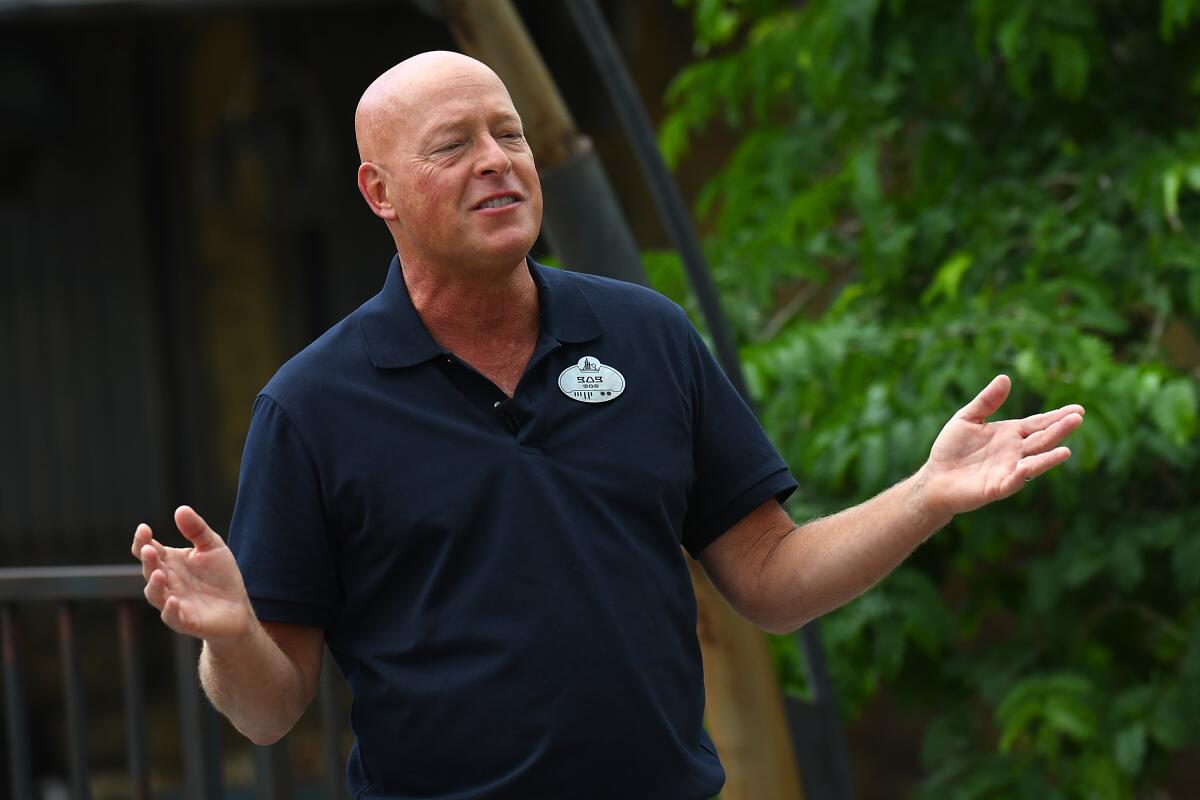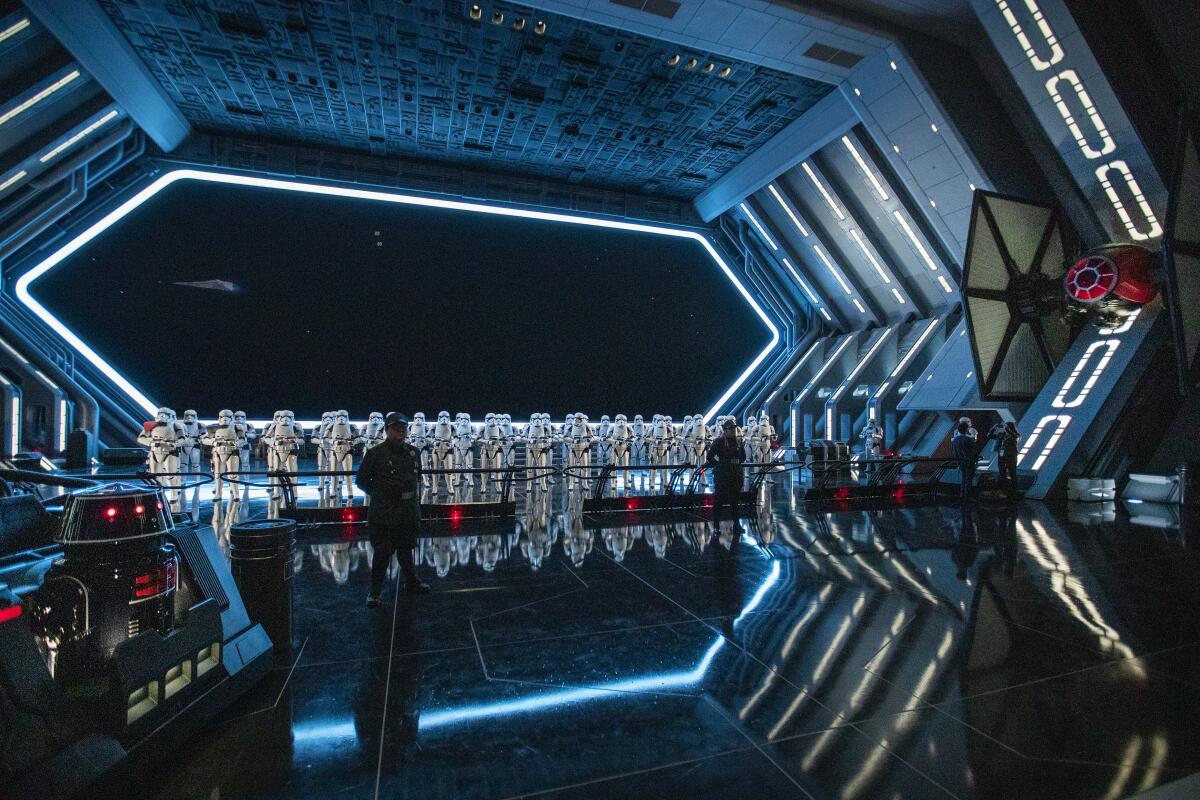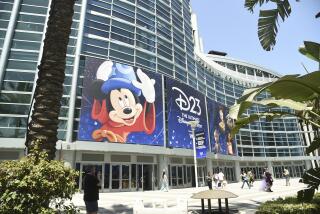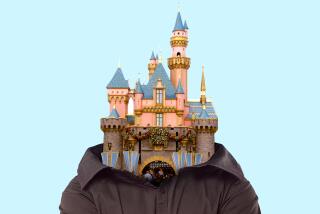Commentary: Bob Chapek as CEO is a vote of confidence in Disney’s parks. What does that mean for Disneyland?

Running the Walt Disney Co. isn’t unique simply because of its vastness or the diversification of its portfolio. It is the rare entertainment conglomerate whose products are not meant to solely be seen and watched; Disney, via its theme parks, is in the business of crafting environments, cultural institutions that not only represent a brand but stand as physical manifestations of human ideals and myths.
So when it was announced Tuesday that Bob Chapek, who for the last five years has overseen Disney’s parks, would immediately succeed Bob Iger as Disney chief executive, the news resonated far beyond Wall Street. For there are many who debate the merits and micro-decisions of the companies run under a Disney CEO the way we argue about the owner of a sports team.
After all, the Disney CEO is responsible for brands that manifest themselves in the world we live in, and they lead products that bleed into our personal lives and those of our family and friends.
Although Disney theme parks are sometimes derided as fake spaces, they’re arguably no less real than buildings that dot Los Angeles. A child‘s plaything is a cheap merry go-round, but Disneyland, including the recently opened 14-acre expansion Star Wars: Galaxy’s Edge, is a full-scale virtual world, one with ideas about everything from urban planning to corporate synergy to how we play.
That last idea of play cuts to the park’s enduring appeal and explains how Disneyland gets away with endless price increases without sacrificing much of its popularity. For when we are free to play — to experience life inside a narrative-driven fantasy world that’s disassociated from the cacophony of daily life — we are, at long last, at emotional ease. (At least those of us not turned off by strollers or crowds.)
Bob Chapek, a 22-year veteran of Walt Disney Co., has been named chairman of the company’s parks and resorts division.
Beyond storytelling and intellectual property, Disney is in the business of guest service, and a brand is more powerful when we can walk among it.
Iger’s tenure, especially when it comes to Disney parks over 20 years, will be noted first and foremost for its big bets on larger-than-life content, with moves such as rebranding Disney California Adventure so it was anchored by Cars Land and the development of Shanghai Disneyland and Hong Kong Disneyland, parks temporarily closed due to the coronavirus crisis. (The closures represent one of the first major challenges that new CEO Chapek will face.)
Chapek suffered somewhat from being in Iger’s shadow. He was the person running the nuts and bolts, the price increases and the daily park operations while Iger was seen as focusing on the bigger picture. Among park fans, it created sort of a good bad/bad cop scenario. But there’s no denying Chapek’s tenure has been a success for the bottom line. When Iger noted that Disney theme park attendance dipped last year, he also stated that revenues were up, indicating that the park’s business had become solvent enough — or expensive enough — to weather any storms.

A quick read of Chapek’s ascension is that the 27-year Disney veteran has earned the CEO role for the way he way he oversaw the company’s themed entertainment business, long the cornerstone of Disney and in recent years the subject of much investment. This is in line with how we consume modern entertainment. After all, the so-called “experience economy” — seen in everything from Tyra Banks’ bid to open ModelLand in Santa Monica to Universal’s own doubling down on properties such as Nintendo — is really the theme park economy. Modern brands are consumed in physical and virtual worlds with lessons learned from old-fashioned storytelling and modern gaming.
The recent launches of Pandora — the World of “Avatar” at Disney’s Animal Kingdom in Florida and Galaxy’s Edge, here at Disneyland and in Walt Disney World, are large-scale investments in environmental storytelling, where each aspect of the land is meant to live in harmony with the other. Those who grew up on Pirates of the Caribbean and the Haunted Mansion may bemoan the lack of an original ride not tied to a film property, but these lands are creations that showcase the strength of Walt Disney Imagineering, the highly secretive division devoted to theme park experiences.

While the Pandora and Galaxy’s Edge Imagineering efforts were underway before Chapek jumped in to lead the company’s parks and resorts division from his perch atop consumer products — which was then experiencing a surge in the wake of “Frozen” — theme park fans have been less than inspired by some of the messaging under Chapek. A poll on Disney fan site MiceChat indicates that die-hard park-goers have yet to give Chapek a vote of confidence. And a quote at the time of the Galaxy’s Edge opening at Disneyland has come to be seen as the Chapek way. Addressing a long-held fan gripe that everything opening at the parks appears to be tied to a movie franchise, Chapek said, “Why does everything have to be franchised-oriented? That’s our barrier to entry. If any of our competitors had our intellectual property, guess what they would be doing? The exact same thing we’re doing.”
While there’s no doubt truth in that worldview, it’s been seen as a sort of mandate that’s trickled down — one intent on placing characters and IP in every nook and corner of Disney’s parks and hotels. There was an immediate fan outcry, for instance, when the Main Street Cinema at Disneyland became a pop-up merchandise shop, even if only for a few days. In a company the size of Disney it’s quite possible that Chapek had nothing to do with such a decision, but it was in line with a business philosophy to maximize every corner of the parks. Worse, for hardcore Disneyland fans, it’s a philosophy that fails to see that Disney theme parks themselves are IP worthy of preservation and celebration.
Disney’s appointment of Chapek to replace Bob Iger surprised Hollywood and Wall Street. But his background may make him well-suited for the job.
So when Galaxy’s Edge, an ambitious and impressive project that Chapek saw to fruition, launched without some of its hyped elements, namely its lack of characters, creatures and droids, fans and media noticed. Once talked up as a sort of live-in video game, Galaxy’s Edge in its early days lacked life. Chapek responded by arguing that retail workers could double as actors: “I like to say that we have more characters in this land than any land we’ve ever done because each one of our cast members has a backstory.”
The statement has been read and dissected, and used as loose evidence that live entertainment is not a priority for the Chapek regime. While Disneyland isn’t devoid of entertainment, be it the vehicles that dot Main Street, U.S.A., the roving pirate band in New Orleans Square or seasonal events such as the winter ¡Viva Navidad! Street Party, regular park guests have noticed a steady dwindling of offerings in recent years.
Individually they are seemingly small — the lack of a dance party on the streets of Cars Land, for instance, or the replacement of Disney California Christmas tree lighting carolers with a recording — but taken as a whole they diminish the Disneyland Resort as a place of live theater. Others are more noticeable, such as the striking of the Pixarmonic Orchestra on Pixar Pier or pulling the Red Car Trolley Newsboys off of Buena Vista Street, which bring the lands to life and invite guests to interact in ways that create lifetime connections.
Also relatively new and worth keeping a skeptical eye on is a walled garden approach, where live entertainment is housed behind pricey one-off events. A 50th anniversary for the Haunted Mansion was filled with weirdness and revelry, but it also cost guests $300 to attend. And once-open areas of the park have been closed off for the use of high-paying customers (the New Orleans Square Court of Angels essentially gifted to the private Club 33) or made a part of tours (a ride in the Lilly Belle parlor car was once a rare but free treat; now it’s part of a tour, one currently slated to return this year).

Yet Disney this year has also launched its most theatrical ride yet in Star Wars: Rise of the Resistance, a melding of an old-fashioned dark ride, theme park trickery and bits of immersive theater. It’s a triumph, and the anchor of lands said to push 10 figures in cost. It’s understandable and expected, of course, that there would be sacrifices with such an investment, even as Rise of the Resistance itself is a testament to the strengths of having Disney staff — cast members, in park parlance — playing a role. The balance of what’s added versus what’s subtracted isn’t an exact science, but it becomes more open to debate when park tickets can now top $200 on some days.
With a five-year run in his most recent role it may be difficult to gauge if Chapek believes the future of Disney Parks is continued heavy investment in spaces like Galaxy’s Edge, a living platform that would still be enhanced by creatures and a special effects show, or relatively quick turnaround attractions like Pixar Pier. Complicating matters is that any major decisions would have likely had to go through Iger’s desk.
A park can have both, of course, and it’s unclear where on the spectrum the upcoming Avengers Campus will fall, but Pixar Pier raised concerns for feeling like something lifted from the early days of Disney California Adventure, when designers were forced to work amid cost-cutting compromises that dispensed with a deep theme in favor of decorations (the static characters of the Incredicoaster stand in contrast to the rest of the park). The early days of the Iger years seemed to be a denunciation of such work.
Bob Iger transformed Disney during his 15-year tenure as CEO; now he’s handing the reins to Bob Chapek, who led the company’s parks division for nearly five years.
But one thing appears here to stay: the the steadily increasing costs of an annual pass, which are filled with the sort of hidden tricks that only a marketing executive could love. The $649 “flex pass” seems like a good deal until one realizes it doesn’t include the time-saving MaxPass, which allows guests to easily book Fastpasses. That’s an extra $125. Nor does it include parking, which is $25 a visit, a cost that could quickly result in dropping an extra few hundred, especially if one aims to visit Disneyland once per month ($300 in this example).
The narrative that Chapek’s strength is business rather creative acumen isn’t helped by the fact that Iger will be staying on for an additional 22 months to “focus on the company’s creative endeavors.” Ultimately, Chapek presented the closest he has for a thesis for the future of Disney parks at last summer’s fan convention the D23 Expo.
“We’re putting in more Disney, more Pixar, more Marvel and more ‘Star Wars’ into our parks,” he said. “Every live show and spectacular should bring your favorite stories to life in thrilling ways.” What he didn’t talk about was theme, which alarmed longtime fans of Florida’s EPCOT, which melded tech, wonder and education with entertainment, and is most decidedly “Disney.”
It’s vague corporate speak that has found its way into Disney’s own descriptions of its work. While EPCOT’s Future World is in massive need of love from Imagineering and is in the midst of a multi-year reinvention, little still has been known about Chapek’s orders other than more Pixar and Marvel. Hours after Disney announced the executive change, new details on the transformation of the spherical icon of the park, Spaceship Earth, spread online.
Many scenes will remain, the Disney Parks Blog told us, including those involving Egypt, only now the scenes “will be transformed through the power of light.” The post adds, “Throughout the attraction, you’ll hear new narration and see how light plays a central role in our shared human journey.” For a ride once centered on human advancements on communication, this description certainly lacked it.
Here’s betting, though, that it will be pretty. The concept art shown was beautifully luminescent. But as to what exactly “the power of light” means to the future of the attraction that anchors a park, we’re still in the dark.
Disney theme parks
More Disney parks coverage from the Los Angeles Times.
More to Read
The biggest entertainment stories
Get our big stories about Hollywood, film, television, music, arts, culture and more right in your inbox as soon as they publish.
You may occasionally receive promotional content from the Los Angeles Times.














